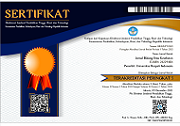Format
1. Writing systematics at least includes Title, Abstract, Introduction, Literature Review and Hypothesis Development (for qualitative research only literature review), Research Methods, Results and Discussion, Conclusions, and References. Thanks/Awards (if any) are placed after the Conclusion and before the Bibliography.
2. Article typed in 11 point font size with 1.5 line spacing on A4 paper, except for direct quotations which are typed with one line spacing and indented style.
3. The upper, lower, left and right sides are at least 3 cm.
4. Articles are written as efficiently as possible according to needs, with article lengths ranging from 10-17 pages.
5. All pages, including references and attachments must be numbered sequentially.
Article Writing Systematics.
1. Title, must show results and not be a process, must be in accordance with the problem to be solved.
2. Abstract, consisting of 150-250 words in English and Indonesian. Abstract provides a summary of the purpose of the article, methods and conclusions of the article. Abstract followed by keywords (keywords) consisting of 3-5 keywords to facilitate the preparation of the article index.
3. The introduction must describe a clear general background, relevant previous studies (State of the Art), gap analysis, novelty or hypothesis statements, ways to approach problem solving, have the purpose of reviewing the article, articles must have adequate reference sources.
4. Research Methods, Explaining the stages of the research, explaining the research methods, being able to explain The tools/materials/framework/platforms/models/equations used have been well explained, Experiments can be repeated with the same results.
5. Results and Discussion, Contains scientific findings (scientific finding), Explains why this could happen, Contains an explanation of conformity or conflict with other research results marked by citations, Explains the implications of both theoretical and applied research.
6. Conclusion, Contains a summary that answers the hypothesis and/or, Contains a summary that answers the research objectives, Contains the potential for developing research results (future research).
7. Bibliography, contains the sources referred to in writing the article written in the Vancouver style format.
Tables and Figures (Graphs)
1. Tables and figures are presented as efficiently as possible (only those presenting results) and included in the manuscript. The tables and figures presented in the appendix show the data processing process.
2. Tables and figures are numbered sequentially and a full title indicates the contents of the tables or figures.
3. References to tables or figures must be given in the manuscript.
4. The author mentions in the part of the manuscript, the place for the inclusion of tables or figures.
5. Tables or figures should be interpreted without having to refer to the text.
6. Source Tables and Figures must be included.
7. Drawings must be prepared in printable form.
Quote
In-text citations are written between parenthesis and closing brackets which state the last name of the author, the year without commas, and the page number if deemed necessary.
1. One source of quotations with one author: (Syafruddin 2001); with two authors: (Habbe and Hartono 2000); more than three authors: (Budiono et al. 1999); more than one source of quotations with different authors: (Mardiyah 2001; Kusumawati 1999); more than one source cited by the same author: (Djakman 1998, 2000).
2. If the quote is accompanied by a page number: (Brownell 1981, 845).
3. If the reference contains authors with more than one article in the same year, use the letters a, b, … after the year in the citation. Examples: (Joni 1999a, 1999b) or (Joni 1999a, Daud 2000b).
4. If the author's name is mentioned in the text, then the name does not need to be mentioned in the quotation. Example: "Alamsyah (1998) states ..."
5. Sources of quotations originating from the work of an institution should state the acronym of the institution concerned, for example (IAI 1994).
Reference
Each article must contain a bibliography (only those that serve as sources of citations) which are arranged alphabetically according to the last name of the author or the name of the institution. Example:
Books
Lawhead JB, Baker MC. Introduction to veterinary science. Clifton Park (NY): Thomson Delmar Learning; 2005.
Edited book
Meltzer PS, Kallioniemi A, Trent JM. Chromosome alterations in human solid tumors. In: Vogelstein B, Kinzler KW, editors. The genetic basis of human cancer. New York: McGraw-Hill; 2002.p. 93-113.
Thesis and Dissertation
Agustin P. Effect of Giving Quercetin Nanocrystals on Acute Kidney Failure Induced by Gentamicin [thesis]. Padang: Faculty of Pharmacy, Andalas University; 2017.
Online Articles
Pullen LC. Antibiotic Resistance Continues to be a Problem in Children [Internet]. Medscape. 2017 [cited 29 December 2017]. Available from: https://www.medscape.com/viewarticle/860801
Footnote
Footnotes are used only to provide additional explanation/analysis, which if combined into the manuscript will disrupt the continuity of the manuscript. Thus footnotes are not used for reference. Footnotes must be numbered in a superscript printed sequence. The text of the footnote is placed directly on the page containing the superscript number.
Policy on Plagiarism
Every author who submits an article to PAMAS Journal must make a statement that the manuscript is free from plagiarism and is not being considered and published in another journal.
Policy on Data Availability
Consistent with the objectives of the PAMAS Journal, article authors are expected to be able to provide the data they have to those who need them and provide information on how to obtain the data. If the article uses a survey or experimental approach, all instruments (questionnaires, cases, interview plans, etc.) must be attached.














